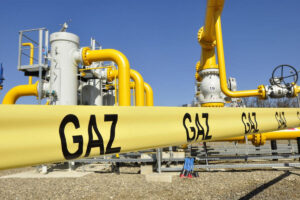
Azerbaijan’s state oil company SOCAR has begun developing an oil field in Uzbekistan. This was announced by Azerbaijani President Ilham Aliyev on August 22 at a trilateral meeting with the President of Uzbekistan and the Chairman of the Halk Maslahaty of Turkmenistan in Turkmenbashi.
“We have traditional energy cooperation with Turkmenistan. We have already entered this field with Uzbekistan. Our state oil company SOCAR has already begun developing an oil field in Uzbekistan, and the contract has already been signed,“ Aliyev said.
According to him, Azerbaijan expects to receive ”good news” about the results of the work within the next year or two. “We are all eagerly awaiting news about the discovery of a large oil field in Uzbekistan,” he said.
On July 24, Uzbekistan and the Azerbaijani state-owned company SOCAR signed a production sharing agreement (PSA) for the Ustyurt Plateau.
Investments in the project are estimated at $2 billion. Over the next five years, SOCAR, which is the project operator, will conduct 3D seismic surveys covering an area of at least 1,000 square kilometers and drill at least one exploration well. If a commercial field is discovered, the parties will proceed with its development. Reserves are estimated at up to 100 million tons of oil and 35 billion cubic meters of gas.

China increased oil production by 1.3% in January-July compared to the same period last year, to 126.6 million tons, according to the State Statistical Office.
In July alone, production rose by 1.2% to 18.12 million tons.
Oil refining for the seven months totaled 424.68 million tons, up 2.6% from the same period in 2024. In July alone, it rose 8.9% to 63.06 million tons.
Natural gas production in the country in January-July increased by 6% and reached 152.5 billion cubic meters, according to the GSU report. Last month, production rose by 7.4% to 21.6 billion cubic meters.

The US has postponed sanctions against Serbian oil company NIS for the last time: a key company could be at risk
The United States has postponed for the fifth and final time the imposition of sanctions against Serbian oil company Naftna Industrija Srbije (NIS), which is controlled by Russia’s Gazprom. According to Reuters, the new exemption from the sanctions list has been extended until the end of August. No further extension is planned after that.
Serbian Energy Minister Dubravka Čedović Handanović said that Belgrade wants to keep oil supplies stable and called “the exclusion of NIS from OFAC sanctions a priority.” She said that dialogue between the US and Russia remains an important condition for this.
NIS is a strategically important company for the Serbian economy. It operates the country’s only oil refinery in Pančevo (near Belgrade), as well as the largest network of gas stations and logistics infrastructure in the fuel sector.
According to the ownership structure:
• 44.9% of NIS shares are owned by Gazprom Neft (Russia),
• 11.3% by Gazprom,
• 29.9% by the Serbian government,
• the rest by minority investors.
It was Russian control over the majority of shares that led to NIS being sanctioned by the US Treasury Department’s Office of Foreign Assets Control (OFAC). Initially, the company was to be completely blocked in January 2025, but since then it has received four temporary licenses to continue operations.
In July 2025, NIS applied for a temporary license for the fifth time and received it for one month, until the end of August. During this period, Gazprom Neft was again reminded of the requirement to withdraw from the Serbian company’s shareholders.
Analysts note that if the sanctions are imposed in full, this could destabilize the fuel market in Serbia, create logistical disruptions, and cause oil prices to rise.
An alternative could be a transfer of control from Russian shareholders to European or Middle Eastern investors, but negotiations on this issue have not yet been officially confirmed.
NIS is a leader in the Serbian petroleum products market and is actively developing its operations in Romania, Bulgaria, and Bosnia and Herzegovina.
The company is also involved in oil and gas exploration and production, lubricant manufacturing, and power generation.
Source: https://t.me/relocationrs/1228

The Organization of Petroleum Exporting Countries (OPEC) has published a long-term forecast for the period until 2050, according to which oil and natural gas will remain the main sources of energy, occupying more than half of the global energy balance. This confirms the importance of hydrocarbons in the global economy and the strategic nature of energy policy.
Oil and gas demand forecast
The key drivers are:
Contradictions with other forecasts
This outlook indicates that oil and gas will retain its prominent position for at least the next 25 years. And while renewable energy is rapidly gaining momentum, the transition away from the traditional energy system must be smooth and gradual, taking into account real economic and social factors.

The introduction of quotas on Ukrainian oil imports by the European Union in mid-June led to an increase in domestic prices for the product, industry analytical agency Infagro reported on Wednesday.
“In the first two weeks of the quotas, Ukrainian suppliers have already used about 25% of the allocated volume, and demand from European buyers remains high due to the price difference,” analysts said.
They noted that dumping in the trade of Ukrainian butter is causing discontent among Polish producers, which could negatively affect negotiations on further expansion of trade privileges for Ukraine. The European Commission is already taking these signals into account, the report said.
According to experts, preliminary estimates show that despite a pause in exports at the beginning of the month, significantly more of this product was exported from Ukraine in June than in the first quarter on average. The main driver was high export prices: in the EU — $7,300–7,500/ton (FCA), in Moldova — at least $7,000/ton.
At the same time, in the second half of June, domestic prices for oil continued to rise.
“Despite the decline in production compared to May, oil production in July is expected to be significantly higher than last year,” Infagro predicts.

Oil prices accelerated their rise on Thursday afternoon as investors continued to monitor the Iran-Israel conflict, fearing supply disruptions if it escalates further.
The price of August Brent futures on the London ICE Futures exchange rose by $0.63 (0.82%) to $77.33 per barrel as of 13:53 GMT.
WTI oil contracts for July on the New York Mercantile Exchange (NYMEX) rose by $1.07 (1.42%) to $76.21 per barrel.
The situation in the Middle East remains in the spotlight. Investors are most concerned about the threat of restrictions on shipping in the Strait of Hormuz, which could lead to significant disruptions in oil supplies. The lack of clarity regarding US plans for involvement in the Iranian-Israeli conflict is negatively affecting market sentiment.
US President Donald Trump said on Wednesday that he had not yet made a final decision on how to resolve the Iranian issue. He reiterated that he did not rule out resuming talks with Tehran. At the same time, Trump noted that the outcome should be guarantees that Tehran will not have nuclear weapons.
The unpredictability that characterizes Trump’s foreign policy “is causing nervousness in a market that is looking for clearer signals that could affect global oil supplies and regional stability,” said Priyanka Sachdeva, an analyst at brokerage firm Phillip Nova.
RBC Capital Markets analyst Helima Croft believes that the threat of serious supply disruptions will increase if Iran feels a real threat to its existence. In her opinion, US involvement in the conflict could provoke direct attacks on tankers and energy infrastructure.
Meanwhile, according to data published yesterday by the US Department of Energy, commercial oil reserves in the country fell by 11.473 million barrels last week, marking a record drop since June last year. Experts had expected a decline of 2.3 million barrels, according to Trading Economics.
Gasoline inventories increased by 209,000 barrels, distillates by 514,000 barrels. Inventories at the Cushing terminal, where oil traded on the New York Mercantile Exchange (NYMEX) is stored, fell by 995,000 barrels.